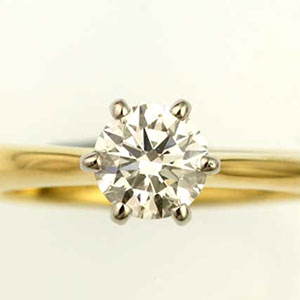Blinded by the Light
(or: Why every engagement ring you've ever seen is ugly)
Marcel Tolkowsky has a lot to answer for.
In an instance of apparent celestial humour, he was born on Christmas Day in 1899, an unsung messiah for the zenith of the material age. Just on the cusp of a new century, one upon which he was to have a profound and disproportionate influence. In keeping with the symmetry for which he is most renowned, in 1919 he published a PhD thesis containing the specifications for the ideal Round Brilliant Cut of a diamond. He defined mathematically the optimum number of facets, their proportion and arrangement so that 100% of the light entering a diamond was refracted and reflected back through the top of the gem, achieving the perfect amount of brilliance and fire from the perfectly-cut stone. In this pinnacle of the stone-cutter’s art, he unleashed a century of bling.

To be fair he was only a single leg of the triumvirate that destroyed jewellery in the 20th century, the other two being the perfect global marketing campaign by DeBeers, along with the mass manufacturers’ glee in saving weight and increasing their profit margin, earning more while selling the consumer less and less on an annual basis.
It has long been one of the subtleties of a master goldsmith that they were capable of fashioning a ring that could artfully hold a gem for the appreciation of the wearer while gracefully achieving a degree of discretion with their metalwork. This heavy and dense, hard to manipulate, stubborn and expensive material would twist and shine, letting the wearer’s notice slip and bounce off its surface, leading the eye in an illusion upwards and to the centre, to the only point of focus, that fabulous light.
The master craftsmen contented themselves with the quiet triumphs of beautifully articulated edges, degrees of taper, balanced weights, galleries and nuanced detail providing structural support for the centre stage actors above them. Their purpose was to hold the gemstone for its own beauty, their success contributed to their own downfall.
Like the signatures inside a Stradivarius, denoting the workers keeping the spirit of the instrument alive, for the most part the only people who would appreciate the subtleties of the craft were other fellow craftsmen and bench workers and, perhaps in the future, the discerning collector or the well-informed expert on Antiques Roadshow.
As the greatest monopoly of the century propagated the desirability of the diamond engagement ring, everyone had to have one. Production was put to the pin of its collar to feed the demand, and if you could save a fraction of a gram here, shave a little weight there, you could handsomely reward yourself at the end of the year’s work, shipping thousands of rings to the far flung corners of the planet. The achievement of the optimum amount of bling drew everyone’s eye. One casts a cursory glance at the setting underneath the gem, but with a sad selection of mediocrity, it isn't the fault of the consumer that they have dross to choose from. The trade, in its ease of stunning the public with sparkles, is guilty of gradually distilling the structure of the engagement ring until all that is left is banal muck which has lost all touch with the original motivations that defined its purpose. After all the character has been removed, one can only reiterate and simplify copies of copies for decades until there is nothing of substance left.
We are approaching the 100 year anniversary of Tolkowsky's landmark achievement. And while we have the benefits of his insight in the precious gem, I believe that the result has been the eventual reduction of the goldsmith’s art, for the most part, to an automatic regurgitation of thrice-chewed cud. While the hip-hop community flash as much as they can physically hold, and fashionable belles try for the largest size at the cheapest price, the diamond designed by Tolkowsky stands foremost, as a shining shield to prevent the eye from discerning if there is anything of merit beyond its brilliance. Much of the grace, elegance, or reason that once underpinned the object itself has been lost.
